#Anis Mansour
Explore tagged Tumblr posts
Text
A la belle étoile (Movie Review) | Hardships and Resilience with No Cheesy Sentimentality
#ALaBelleEtoile is a beautiful heartfelt #FrenchFilm based on a true story with commercial worthy pastry sequences and solid acting. #RiadhBelaiche #JustRiadh #SebastienTulard #YazidIchemrahem #MovieReview
Even though I speak the language and France has a rich cinema history, I don’t often watch French films. I’m making a bigger effort this year since I noticed that Waiting for Bojangles was the only French movie I’d reviewed. This movie, A la belle étoile is a movie based on the life of award-winning Pastry Chef Yazid Ichemrahem, and his book “Un Rêve d’Enfant Etoilé.” Cedric Ido is scripting and…

View On WordPress
#A la Belle étoile#Alioune Sané#Anis Mansour#Ary Gabison#Based on a book#Based on a novel#Book adaptation#Book to Film#Book to Movie#Cédric Ido#Christelle Berthevas#Christine Citti#Comedy#Drama#Dycosh#Estéban#Frédéric Fix#Georges Corraface#Jean-Yves Berteloot#Laurence Lascary#Lika Minamoto#Loubna Abidar#Marwan Amesker#movie lovers#movie review#movies#Pascal Légitimus#Phénix Broussard#Radostina Rogliano#Review
0 notes
Text
Lesbian and gay solidarity
#sas rogue heroes#sas: rogue heroes#david stirling#eve mansour#connor swindells#sofiaboutella#sorry I can't take them any other way
26 notes
·
View notes
Text

#The neutral is someone who did not support falsehood(wrong)#but he certainly failed the truth(right)#~Anis Mansour [864 x864]
6 notes
·
View notes
Text
Hello everyone, I hope you are well 👋👋
I am Mansour Subhi Al-Jizawi, a citizen of Gaza. I come to you with a broken heart and ask for help for me and my family...
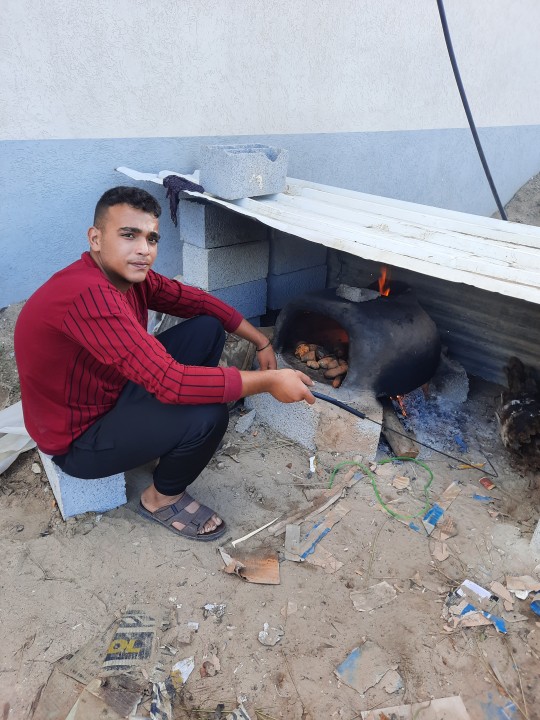
I am writing to you and asking for help in any way to restore what the occupation has destroyed since October 7, 2023.So that I and my family can survive the war and save the rest of our lives because Gaza has become uninhabitable. There is no longer a suitable place to live. There is no solution other than evacuation to survive... but unfortunately the price of evacuation from Gaza is very expensive... and we cannot bear these costs. There is no solution but to help you by donating, sharing our story, or praying for us....
I am talking to you, and after thinking for a long time before taking this step, but I realized that there is nothing left for us in Gaza after the occupation destroyed all its property, our property, our dreams and our future...so I came to you and I am full of hope from you that your donations will cover the cost of survival. Evacuation to a better life....
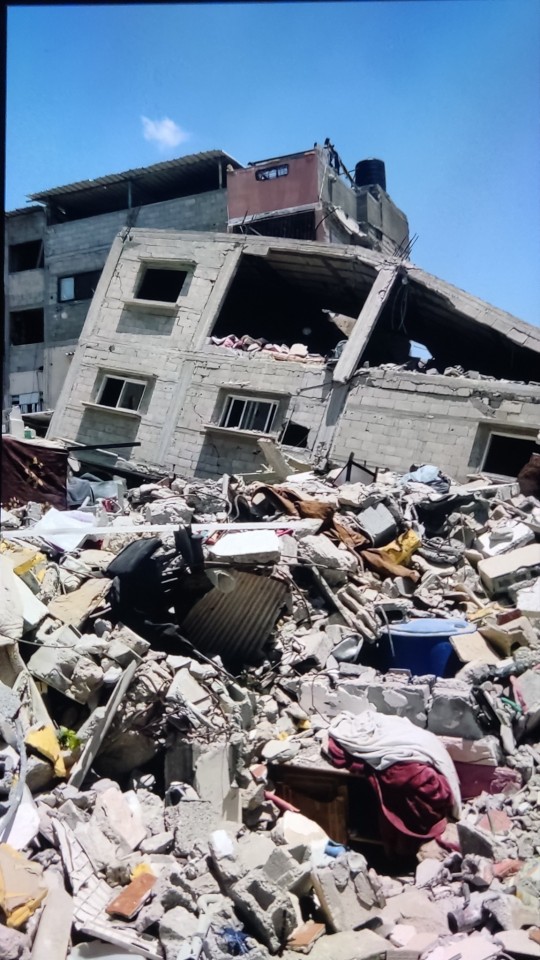
The occupation destroyed our home, our dreams, and the buildings of my family and I to live in tents after it ordered and forced us to evacuate from northern Gaza. Currently, we live in a camp in the Zawaida area, and this is the ninth displacement since the seventh of October of the past year, 2023. Struggling daily to obtain clean water and food. And the rest of the necessities of life, despite the high prices that make us struggle more to obtain them...
We are 4 people, the number of people in my family. My father, Subhi Mustafa Al-Gizawi, is 60 years old and currently without any income and does not work for any institution. He has a heart disease and a stroke as well, and needs daily treatment, but due to the difficulty of the situation, he is sometimes not available in the country, and this makes him even more weak. More because of the lack of treatment
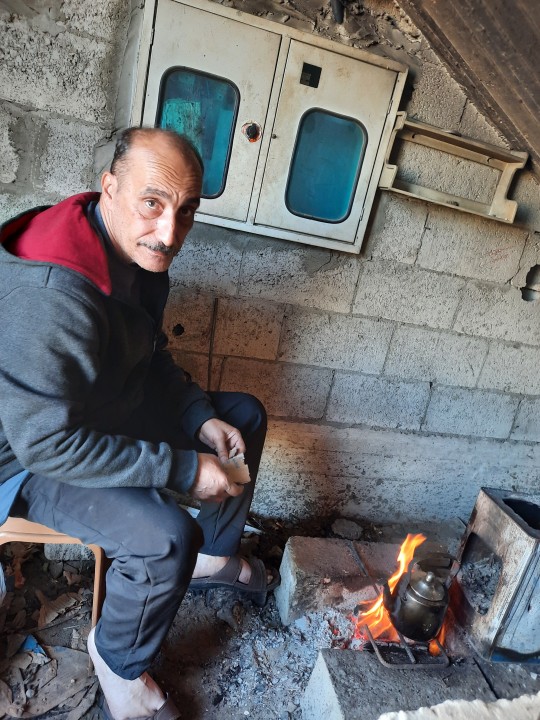
and my mother Mervat Bassam Al-Jizawi, 54 years old, also suffers from high blood pressure and colon, which caused her to undergo operations because of the pain that comes from the colon. She also needs medicine, and this medicine is not available and is expensive...
I am Mansour Subhi Al-Jizawi, 20 years old. I did not receive a university education because of the war. The occupation destroyed my future and left me without a future. I was injured in the 2014 war, and the effects of the injury are still present, and the shrapnel is still stuck in my body 💔

My brother, Tamer Sobhi Al-Gizawi, has been missing since the beginning of the war, and we do not know anything about him..
The remnants of this war are that our house was destroyed and uninhabitable, and our car was completely destroyed.
In conclusion: I hope that receiving my message is very important to you, and that it will make a difference for the Palestinians in need 💔🙏
God bless you all...
#free palestine#save palestine#palestinian genocide#i stand with palestine#all eyes on palestine#free gaza#gaza genocide#gaza strip#gaza#gazaunderattack
531 notes
·
View notes
Text
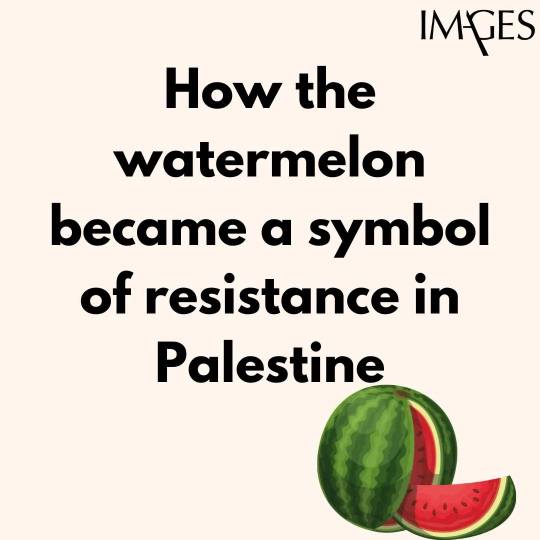


How the Watermelon Became a Symbol of Palestinian Solidarity
The use of the watermelon as a Palestinian symbol is not new. It first emerged after the Six-day War in 1967, when Israel seized control of the West Bank and Gaza, and annexed East Jerusalem. At the time, the Israeli government made public displays of the Palestinian flag a criminal offense in Gaza and the West Bank.
To circumvent the ban, Palestinians began using the watermelon because, when cut open, the fruit bears the national colors of the Palestinian flag—red, black, white, and green.
The Israeli government didn't just crack down on the flag. Artist Sliman Mansour told The National in 2021 that Israeli officials in 1980 shut down an exhibition at 79 Gallery in Ramallah featuring his work and others, including Nabil Anani and Issam Badrl. “They told us that painting the Palestinian flag was forbidden, but also the colors were forbidden. So Issam said, ‘What if I were to make a flower of red, green, black and white?’, to which the officer replied angrily, ‘It will be confiscated. Even if you paint a watermelon, it will be confiscated,’” Mansour told the outlet.
Israel lifted the ban on the Palestinian flag in 1993, as part of the Oslo Accords, which entailed mutual recognition by Israel and the Palestinian Liberation Organization and were the first formal agreements to try to resolve the decades-long Israeli-Palestinian conflict. The flag was accepted as representing the Palestinian Authority, which would administer Gaza and the West Bank.
In the wake of the accords, the New York Times nodded to the role of watermelon as a stand-in symbol during the flag ban. “In the Gaza Strip, where young men were once arrested for carrying sliced watermelons—thus displaying the red, black and green Palestinian colors—soldiers stand by, blasé, as processions march by waving the once-banned flag,” wrote Times journalist John Kifner.
In 2007, just after the Second Intifada, artist Khaled Hourani created The Story of the Watermelon for a book entitled Subjective Atlas of Palestine. In 2013, he isolated one print and named it The Colours of the Palestinian Flag, which has since been seen by people across the globe.
The use of the watermelon as a symbol resurged in 2021, following an Israeli court ruling that Palestinian families based in the Sheikh Jarrah neighborhood in East Jerusalem would be evicted from their homes to make way for settlers.
The watermelon symbol today:
In January, Israel’s National Security Minister Itamar Ben-Gvir gave police the power to confiscate Palestinian flags. This was later followed by a June vote on a bill to ban people from displaying the flag at state-funded institutions, including universities. (The bill passed preliminary approval but the government later collapsed.)
In June, Zazim, an Arab-Israeli community organization, launched a campaign to protest against the ensuing arrests and confiscation of flags. Images of watermelons were plastered on to 16 taxis operating in Tel Aviv, with the accompanying text reading, “This is not a Palestinian flag.”
“Our message to the government is clear: we will always find a way to circumvent any absurd ban and we will not stop fighting for freedom of expression and democracy,” said Zazim director Raluca Ganea.
Amal Saad, a Palestinian from Haifa who worked on the Zazim campaign, told Al-Jazeera they had a clear message: “If you want to stop us, we’ll find another way to express ourselves.”
Words courtesy of BY ARMANI SYED / TIME
#human rights#equal rights#freedom#peace#free palestine#palestine#free gaza#save gaza#gaza strip#gazaunderattack#hamas#watermelon#flag#time magazine#armani syed#amal saad#haifa#zazim campaign#palestinian flag#khaled hourani#nabil anani#genocide#apartheid
3K notes
·
View notes
Text
Mansour Shouman on X: "URGENT: we believe (based on credible sources) that Mansour Shouman has been taken in by IDF. If you have any urgent info. Email: [email protected] We need your help. Please use the QR code to email the PM Trudeau and Minister Joly to take immediate action. Link… https://t.co/9ul3yVh4pD" / X
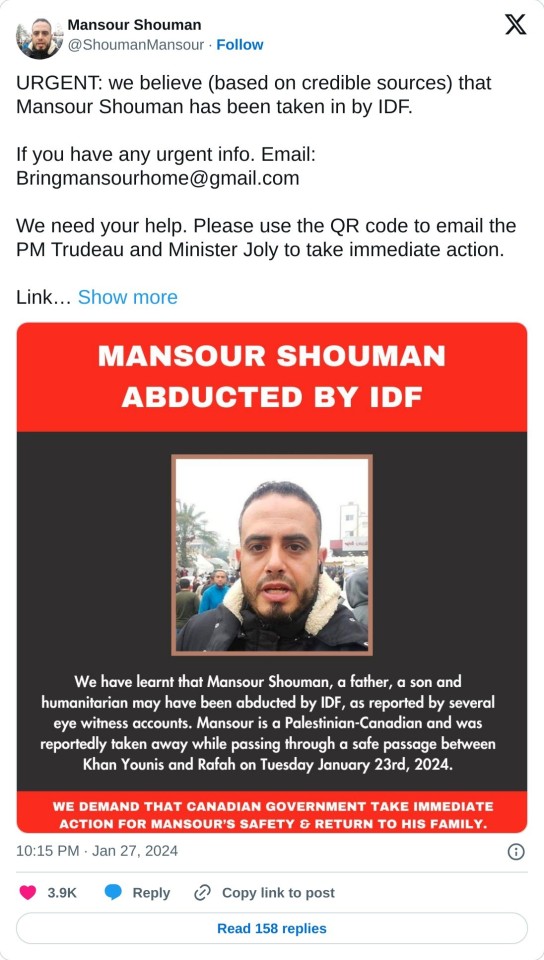
2K notes
·
View notes
Text
Save Me and My Family from War and Help Me Complete My Educatio
Hello everyone, my name is Mohammed El-Zenati. October 7, 2023, was supposed to be the first day of my new academic year at university. But on that same day, the Gaza Strip was subjected to a violent and unprecedented attack by the Israeli occupation. My home, like many others, was destroyed, and thousands of innocent civilians, including women and children, lost their lives. Over a million and a half people were forced to flee, and I was among them. I began a journey in search of safety for myself and my family, being displaced more than seven times, not knowing when it will happen again.
In that single day, everything I cherished vanished—my memories, dreams, and ambitions. Even the landmarks of my city, along with the entire educational system, were obliterated. My university was completely destroyed, and with it, my hope of graduating from the College of Engineering. My future now feels uncertain, as I don’t know when I’ll be able to resume my studies or when my university will be rebuilt. But I hold on to the belief that education is my right. I am a student, and no matter what, I won’t allow any circumstance to take that right away from me.
Your kindness and support can turn despair into hope. It can be the hand that lifts me from this hardship and helps me rebuild my life, dreams, and ambitions from scratch. With your help, I believe that I can transform this suffering into a story of resilience and success.
Donate
This GoFundMe campaign is my plea to rebuild my life and continue my education oiutside Gaza, after everything I knew was taken away.
Vetted by @gazavetters
my number verified on the list is ( #273 )
256 notes
·
View notes
Text
Riyad Mansour, Palestinian Ambassador, addressed the general assembly. From Al Jazeera:
Riyad Mansour, Palestinian Ambassador to the UN, is addressing the UN General Assembly.
Here is some of what he has said:
I stand before you as more than 35,000 Palestinians have been killed, 80,000 have been maimed, two million have been displaced, and everything has been destroyed.
Israel’s plan has not changed: destroy and displace. The world is barely beginning to grasp the cruel and extensive nature of the actions against the Palestinian people.
I stand before you as the Israeli prime minister is ready to kill thousands more to ensure his political survival.
As we speak, 1.4 million Palestinians in Rafah wonder if they will survive today and where they will go next. There is nowhere left to go.
We did not write the UN Charter. We did not enact international laws. We just demanded to see them applied to us and have until now been denied their protection.
A yes vote is a vote for Palestinian existence, it not against any state, but it is against the attempts to deprive us of our state. That is why the Israeli government is so opposed to it, because they oppose our independence and the two-state solution altogether.
If you do not support our freedom, you do not support peace.
508 notes
·
View notes
Text
Today is Erev Yom Ha'Shoah (Eve of Holocaust Memorial Day) in Israel. It will be observed by Jews outside of Israel, too.

The Hebrew date was chosen to honor the outbreak of the Warsaw Ghetto Uprising. It's also a week before Erev Yom Ha'Zikaron Le'Chalalei Ma'archot Yisrael (Eve of Israel's Memorial Day for its Fallen Soldiers and Terror Victims), which is itself observed a day before Yom Ha'Atzmaut Le'Yisrael (Israel's Independence Day). A lot of people have remarked on the connection between the three dates. On Yom Ha'Atzmaut, we celebrate our independence, which allows us to determine our own fate, and defend ourselves without being dependent on anyone else, right after we remember the price in human life that we have paid and continue to pay for this independence, and a week before we mourn the price we've had to pay for not getting to have self defence during the Holocaust. NEVER FORGET that in one Nazi shooting pit alone (out of almost two thousand) during just 2 days (Erev Yom Kippur and Yom Kippur 1941), more Jewish men, women and kids were slaughtered than in the 77 years since Israel's Independence War was started by the Arabs. This unbreakable connection between the living and the dead, between our joy and our grief, is often addressed with the Hebrew phrase, במותם ציוו לנו את החיים, "With their death, they ordered us to live."

On this Erev Yom Ha'Shoah, I'd like to share with you some data, published on Thursday by Israel's Central Bureau for Statistics (source in Hebrew).
The number of Jews worldwide is 15.7 million, still lower than it was in 1939, before the Holocaust, 85 years ago (that is what a genocide looks like demographically).
7.1 million Jews live in Israel (45% of world Jewry) 6.3 million Jews live in the US (40% of world Jewry)
Here's the data for the top 9 Jewish communities in the world:
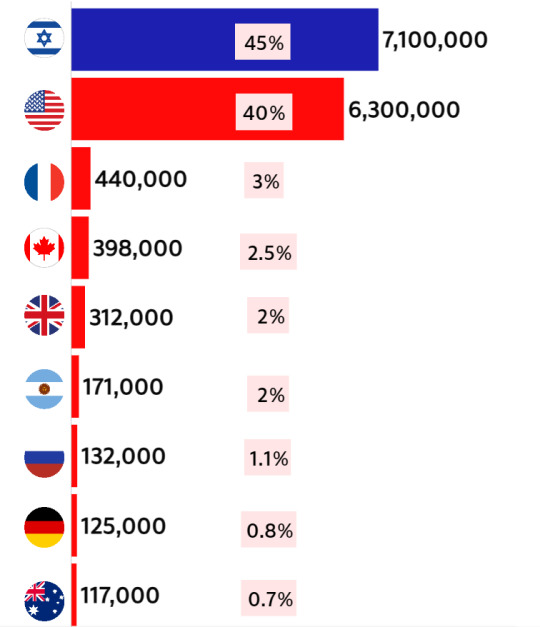
There are about 133,000 Holocaust survivors currently living in Israel. Most (80%) live in big cities in central Israel. Around 1,500 are still evacuated from their homes in northern and southern Israel due to the war (back in January, on International Holocaust Remembrance Day, there was a report about 1,894 survivors who also became internal refugees due to the war. Source in Hebrew). One Holocaust survivor, 86 years old Shlomo Mansour, is still held hostage in Gaza. He survived the Farhud in Iraq.
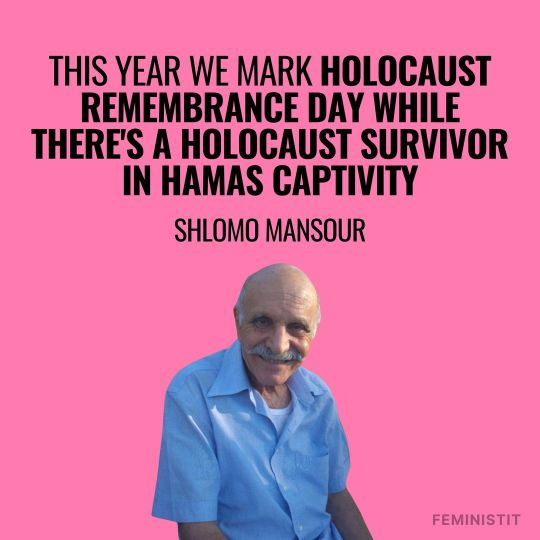
I haven't seen any official number for how many survivors had been slaughtered as a part of Hamas' massacre, despite everyone here being aware that Holocaust survivors had been murdered on Oct 7, such as 91 years old Moshe Ridler. Maybe, as we're still discovering that some people thought to have been kidnapped during the massacre, were actually killed on that day, no one wants to give a "final" number while Shlomo has not yet been returned alive.

Out of all Israeli Holocaust survivors, 61.1% were born in Europe (35.8% in the countries of the former Soviet Union, 10.8% in Romania, 4.9% in Poland, 2.9% in Bulgaria, 1.5% in Germany and Austria, 1.3% in Hungary, 4.2% in the rest of Europe), 36.6% were born in Asia or Africa (16.5% in Morocco, 10.9% in Iraq, 4% in Tunisia, 2.6% in Libya, 2.1% in Algeria, 0.5% in other Asian and African countries) and 2.3% were born elsewhere.
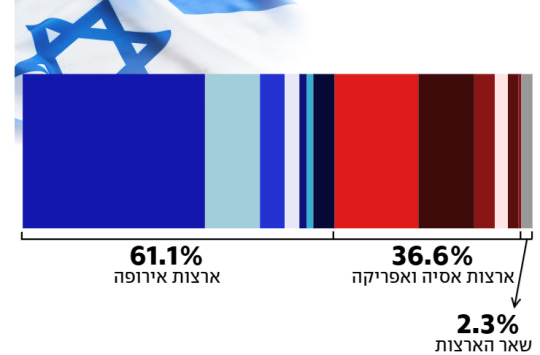
Out of all Holocaust survivors in Israel, 6.2% managed to make it here before the establishment of the state, despite the British Mandate's immigration policy against it (up until May 13, 1948). 30.5% made it to Israel during its very first years (May 14, 1948 until 1951), another 29.8% arrived in the following decades (1952-1989), and 33.5% made Aliyah once the Soviet Union collapsed, and Jewish immigration to the west (which included Israel) was no longer prohibited by the Soviet regimes (1990 on).
The second biggest community of survivors in the world is in the US, the third biggest (but second biggest relative to the size of the population) is in Australia. I heard from many Holocaust survivors who chose to immigrate there that they wanted to get "as physically far away from Europe as possible."
For a few years now, there's been this project in Israel, called Maalim Zikaron, מעלים זיכרון (uploading memory. Here's the project's site in Hebrew. In English it's called Sharing Memories, and here's the English version of the site) where Israeli celebs are asked to meet up with a Holocaust survivor (it's done in Hebrew), and share the survivor's story and the meeting on their social media on Erev Yom Ha'Shoah (which is today). Each year, there's also one non-Israeli Jewish celeb asked to participate (in English. This time around it's Michael Rapaport, he's meeting Aliza, an 81 years old survivor from the Netherlands, who was hidden along with 9 other Jewish babies for two years. He uploaded a preview of his meeting with her here, where he asked her what it means to her to be a Jew, and from what I understand, he will upload more today to the same IG account). This year, there will be an emphasis on Holocaust survivors who also survived Oct 7 (with 6 of the 20 participating survivors having survived Hamas as well). Here's a small bit from an interview with one such survivor, 90 years old Daniel Luz from kibbutz Be'eri:
(for all of my updates and ask replies regarding Israel, click here)
#israel#antisemitism#israeli#israel news#israel under attack#israel under fire#terrorism#anti terrorism#hamas#antisemitic#antisemites#jews#jew#judaism#jumblr#frumblr#jewish#israelunderattack#shoah#holocaust
466 notes
·
View notes
Text
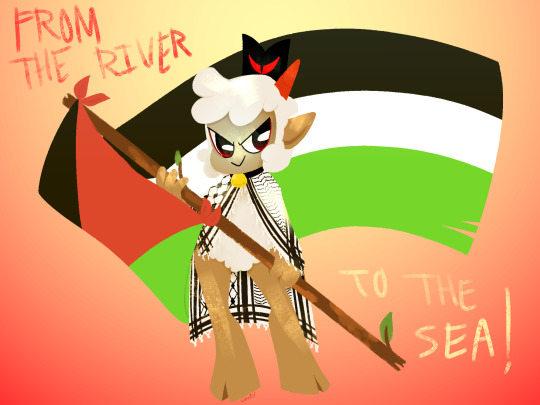
The genocide cannot continue, ceasefire now and forever.
I am still here, the last week I chose more to give the genocide in Palestine some additional boosting, since I do not see live updates as frequently on here. As the global strike draws to a close, continue to give Palestine and other countries a platform to further encourage peace for the oppressed and ultimately liberation.
RESOURCES:
Decolonize Palestine <- a whole website dedicated to learning about Palestinian history, also serves to dismantle the anti-Palestine rhetoric boasted by oppressors.
Esims for Gaza <- these are high priority, they allow people internet access including journalists who document what's happening on the ground.
Care for Gaza, Official Twitter <- non-profit charity that has a team dedicated to delivering primarily food.
Original Kufiya <- from "the last and only factory in Palestine", this textile has become a symbol of Palestinian liberation.
Pious Projects, Feminine Hygiene for Gaza project; <- another crowdfunded charity with many projects not exclusive to Gaza! Do note at the time of writing that feminine hygiene kits have reached 500k/150k$, which means you have a chance to donate to additional projects that haven't met their funding goals yet!
Accountability Archive<- If you see a leader, politician, government body, or anybody participating in the dehumanization of Palestinians, put it here! You can copy and paste URLs, and according to their website there has been over 7000+ submissions so far.
UNRWA (THREATENED) <- organization that distributes aid to Palestinians, now nine countries have CUT OFF FUNDING due to allegations of staff members being associated with the October 7th Hamas attack. You can donate through their website.
BOYCOTT AND PETITION:
The Official BDS list<- the list that has since went viral along side increasing visibility of the genocide; the list is updated fairly often and has a plausible amount of items to boycott.
Eurovision 2024 Boycott, Change.org petition<- Israel is still allowed to compete in the upcoming Eurovision 2024. The link leads to a contact list of broadcasters that you can contact to encourage the banning of Israel from performing in Eurovision. If nothing changes, simply do not watch Eurovision this year!!
Bring Mansour Home <- A Palestinian Canadian journalist who was very recently reported missing, witnesses say he was apprehended by the Israeli Defense Forces passing through a 'safe' passage. Link is an anonymous google document of people you can contact to advocate for Mansour's safety and return.
Help Noury Afford Emergency Surgery <- @Noony_Boony, also Noury, has been in Palestine before and during the genocide. Notable for documenting personal experiences like many other journalists, Noury specifically reminds us outside Palestine that people are not just numbers, they have dreams, fears, and places in fandom. Link is a GoFundMe where her entire family needs emergency surgery for injuries they suffered after getting hit with what is assumed tank shell in a school.
if there are any additional sources you want me to place here, or any links that are broken/need updating, pleaaaaase let me know!!!! :)
Do not be upset if you cannot donate or boycott all the things, just don't lose hope and keep spreading the word!!! This cannot be brushed under the rug, the genocide has gone on long enough!!
#cult of the lamb#cotl#cotl lamb#this was going to be a small post but i decided Palestine deserves more than a fan art#so this became a masterpost#israel#gaza#genocide#ethnic cleansing#palestine#i/p#i/p conflict#signal boost#boosting
369 notes
·
View notes
Text
Three grandchildren of elderly hostages Chaim Peri, Alex Danzig and Shlomo Mansour speak to the press about their grandfathers and the impossibility of celebrating Passover without them. There can’t be a Seder without her grandfather, Alex Danzig, said Talya Danzig, 18, whose 75-year-old grandfather suffers from heart disease. He was taken hostage from Kibbutz Nir Oz. “He leads the show and tells the stories and the jokes,” says Danzig. “It’s called the Seder, but it won’t have any order,” added Danzig, referring to the Hebrew meaning of seder. Noam Safir, granddaughter of 86-year-old Mansour, the eldest hostage, who was taken hostage from Kibbutz Kissufim, tells about her Iraqi-born grandfather’s early years, when his family was caught in the Farhud massacre, in which Jews were killed, raped, tortured, kidnapped and assaulted, their homes and stores looted and burned. “He hid on a roof and cried,” says Safir. “He went through a second Holocaust on October 7.” Safir said his Passover “won’t be the same as previous years, it’s less of a celebration and more of marking the holiday.”
47 notes
·
View notes
Text
A la belle étoile (Movie Review) | Hardships and Resilience with No Cheesy Sentimentality
#ALaBelleEtoile is a beautiful heartfelt #FrenchFilm based on a true story with commercial worthy pastry sequences and solid acting. #RiadhBelaiche #JustRiadh #SebastienTulard #YazidIchemrahem #MovieReview
Even though I speak the language and France has a rich cinema history, I don’t often watch French films. I’m making a bigger effort this year since I noticed that Waiting for Bojangles was the only French movie I’d reviewed. This movie, A la belle étoile is a movie based on the life of award-winning Pastry Chef Yazid Ichemrahem, and his book “Un Rêve d’Enfant Etoilé.” Cedric Ido is scripting and…

View On WordPress
#A la Belle étoile#Alioune Sané#Anis Mansour#Ary Gabison#Based on a book#Based on a novel#Book adaptation#Book to Film#Book to Movie#Cédric Ido#Christelle Berthevas#Christine Citti#Comedy#Drama#Dycosh#Estéban#Frédéric Fix#Georges Corraface#Jean-Yves Berteloot#Laurence Lascary#Lika Minamoto#Loubna Abidar#Marwan Amesker#movie lovers#movie review#movies#Pascal Légitimus#Phénix Broussard#Radostina Rogliano#Review
0 notes
Text
@nadia-el-mansours: that Margo asks Sergei to be her sperm donor one still lives rent free in my mind ngl 😅🤣
"I would like you to be the baby's father."
The bottle of brandy that Sergei had been pouring for them both slipped out of his hand. Margo blinked, resisted the urge to roll her eyes, and instead went for the box of tissues in the bedroom to help mop up the cheap brandy they had stolen from the bar downstairs. When she returned, Sergei was dabbing at the front of his trousers with a handkerchief from his jacket. She offered him a tissue. Considering the possibilities of his reaction, this was one of the more expected ones. As she took over pouring them both a drink, Margo considered the matter closed – his reaction was a clear no.
"Forget I asked." She handed him a drink. "Did you read over Doctor Alpert's new paper? I'm interested to hear your thoughts on his findings."
Sergei, however, was not interested in letting the matter drop. "Margo. You–you want me to be the father of your child?"
Her thumb ran along the rim of her glass. Despite her initial confidence in propositioning him, she now felt apprehensive, exposed. But this wasn't a whim. And this wasn't a random stranger – this was Sergei. She had spent the whole evening talking to him about Aleida's family, how she had enjoyed taking both Aleida and Javi to Huntsville to see the rockets. He had confided in the delightful time he spent with his own nieces and nephew, how he had wanted to be a father but work had kept him from doing so. Confessions on parenthood – both her fears and inherited trepidations – had spilled out over the second half of dinner.
As she achieved everything she set out to professionally, Margo had truly begun to wonder what she could also achieve personally. Raising a child, ideally a little girl who would embrace science and music and her feelings, appealed to Margo. And she couldn't think of a better choice to be their father than Sergei.
"You are the natural choice. You're highly intelligent, kind, with a wonderful sense of humour." Margo took a gulp of her drink. "Being in the Soviet Union would also leave me free to raise the child myself without any interference. I'm not after a husband, Sergei. Just a...donation."
Sergei, seemingly, had moved past his initial shock and had now moved into amusement. "There are no donors in the United States who would meet these criteria? There are no handsome, intelligent, kind, funny men in the United States?"
Margo pointed a finger at him. "I didn't say handsome." She downed her drink. "But Emma has said, on unfortunately more than one occasion, that our children would be pretty cute. She's...not wrong."
He beamed. Margo was now sure that he would agree. All they had to discuss now was whether they would conceive through one of the labs in Houston that she had researched...or the old fashioned way.
#margo x sergei#ficlets#nadia-el-mansours#ship: margo x sergei#how is this crack nearly 500 words???
23 notes
·
View notes
Text
Some background on the Houthis what is happening
Following weeks of Houthi-led attacks on vessels in the Red Sea, the United States and United Kingdom have launched military strikes in Yemen in response, which the Houthis have described as “barbaric”.
The Houthis are an Iran-aligned group based in Yemen and have said their attacks are a response to Israel’s bombardment of Gaza, and the international community’s failure to put an end to it.
[...]
Who are the Houthis?
The Houthis, also known as Ansar Allah (supporters of God), are an armed group that control most parts of Yemen, including the capital, Sanaa, and some of the western and northern areas close to Saudi Arabia.
The Houthis emerged in the 1990s but rose to prominence in 2014, when the group rebelled against Yemen’s government, causing it to step down and sparking a crippling humanitarian crisis.
The group then spent years, with Iran’s backing, fighting a military coalition led by Saudi Arabia. The two warring sides have also repeatedly tried to hold peace talks.
However, analysts say the Shia group should not be seen as an Iranian proxy. It has its own base, its own interests – and its own ambitions.
What’s the status of Yemen’s civil war?
Yemen has been in a decade-long civil war as the Houthis maintain control of parts of the country. The group has been in ceasefire talks with Saudi Arabia while Yemen’s official government is based in Aden and led by President Rashad al-Alimi.
Al-Alimi came into office in 2022 after the country’s exiled president Abd-Rabbu Mansour Hadi ceded power to him. Relations between Hadi and the Houthis were especially fraught.
Yemen’s civil war has plunged the country into what the United Nations called “the world’s worst humanitarian crisis”, in March 2023.An estimated 21.6 million people or two-thirds of Yemen’s population are “in dire need of humanitarian assistance and protection services”, according to the UN.Fighting between Houthis and the military coalition, however, largely subsided last year. In 2023, the Yemeni rebels and government forces also exchanged about 800 prisoners over three days.The Houthis have been engaging in Omani-mediated talks with Saudi officials to negotiate a permanent ceasefire. Saudi Arabia also restored relations with Iran in 2023, raising hopes for the Yemen peace process.
Why have the Houthis attacked Red Sea ships?
The attacks began after the start of the Israel-Hamas war on 7 October.
The Houthis declared their support for Hamas and said they would target any ship travelling to Israel. It is not clear that all of the ships attacked were actually heading there.
In November they seized what they said was an Israeli cargo ship.
They since have attacked several commercial vessels with drones and ballistic missiles.
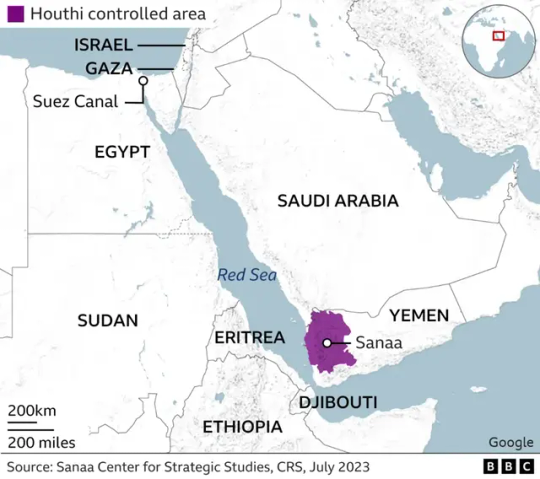
#yemen#iran#saudi arabia#israel#palestine#free palestine#save palestine#gaza#free gaza#save gaza#world news#current events#gaza strip#gazaunderattack#gaza genocide#ceasefire#palestinian genocide#israel palestine conflict#israeli apartheid#middle east#west bank#red sea#yemen civil war#yemen crisis
58 notes
·
View notes
Text
Helpful master list of links for Palestine
Ceasefire Petition
Daily click
Support for displaced families in Gaza
E-sim donations so people can use technology
Menstrual hygiene kits
urge ICJ to invite journalist to testify
FREE MANSOUR FROM THE IDF !!!! URGENT AND ALMOST TO THE 50k GOAL
Send in any links that you think can help 🔗
#will update when i get more links#don’t let this flop please#free palestine#free gaza#palestine#ceasefire#ceasefire now#permanent ceasefire#from the river to the sea palestine will be free#🍉#fuck isnotreal
37 notes
·
View notes
Text
Immigration is one of the most important topics in this presidential election cycle. Former President Trump has promised to conduct a massive deportation effort that would remove millions of people per year. The latest statistics show about 11 million unauthorized immigrants are living in the U.S., and several million more people have arrived in the past two years on parole or with an uncertain legal future. Would a mass deportation effort improve the U.S. economy and provide more jobs for U.S.-born workers? Recent, rigorous economics research sheds light on the consequences of increasing the number of deportations on the U.S. labor market. This research consistently points to deportations hurting the U.S. labor market and leading to worse labor market outcomes for U.S.-born workers.
Landscape of deportations in the US
A deportation is a mandatory departure of a noncitizen out of the U.S. based on a formal order of removal. Official estimates of the cost of deportations are scarce but the best estimates suggest that each deportation costs about $13,000 in current dollars.
There has been a dramatic increase in the number of deportations in the U.S. in the last few decades. Deportations, including removals at the border and those from the interior, increased from about 200,000 per year in the early 2000s to 400,000 per year in the late 2000s. Deportations were then steady at about 300,000 per year until the COVID-19 pandemic. Since the pandemic, deportations of long-term residents have fallen, but other types of removals from the U.S. increased, especially at the border.
A real-world test of the effects of deportation
To isolate the causal effects of deportations on the economy, economists study the rollout of an immigration enforcement policy called Secure Communities (SC). The Secure Communities program increased information sharing between local law enforcement agencies and Immigration and Customs Enforcement (ICE) with the express purpose to identify and deport people who were in the U.S. without authorization. About 400,000 people were deported under SC between 2008 and 2014, after which SC was replaced with the Priority Enforcement Program (PEP). While the first counties implemented SC in 2008, it was implemented county by county with the last counties implementing the program in 2013. The timing of enactment was based on how close the counties were to ICE offices and how quickly the technology could be set up in a county. Bottlenecks in implementation meant some counties were put on waitlists. Because of this, the exact timing of when a county implemented SC was out of their direct control, and counties that adopted the program early compared to late are otherwise very similar. Thus, researchers can compare the labor market outcomes in counties that implemented SC earlier compared to later.
While only people who were arrested had their immigration status checked under SC, the policy nonetheless impacted a large portion of immigrants. There were broad “chilling effects” of the policy that meant even people not targeted for deportation became fearful of leaving their house to do routine things like go to work. This is partly because the program did not only target serious criminals—the most serious criminal conviction for 79% of those deported was non-violent, including traffic violations and immigration offenses, and another 17% were not convicted of any crime.
Increased deportation is associated with poorer economic outcomes for US-born workers
Across multiple studies, economists have found that once SC is implemented, the number of foreign-born workers in that county declines and the employment rate among U.S.-born workers also declines. My research with Annie Hines, Philip Luck, Hani Mansour, and Andrea Velásquez finds that when half a million immigrants are removed from the labor market because of enforcement (due to deportations and indirectly due to chilling effects), this reduces the number of U.S.-born people working by 44,000.
Why do deportations hurt the economic outcomes of U.S.-born workers? The prevailing view used to be that foreign-born and U.S.-born workers are substitutes, meaning that when one foreign-born worker takes a job, there is one less job for a U.S.-born worker. But economists have now shown several reasons why the economy is not a zero-sum game: because unauthorized immigrants work in different occupations from the U.S.-born, because they create demand for goods and services, and because they contribute to the long-run fiscal health of the country.
First, unauthorized immigrant workers and U.S.-born workers work in different types of jobs. Figure 1 shows the percentage of unauthorized immigrant workers, authorized immigrant workers, and U.S.-born workers that are in each of the 15 most common occupations among unauthorized immigrants.



It is clear that unauthorized immigrants take low-paying, dangerous and otherwise less attractive jobs more frequently than both U.S.-born workers and authorized immigrant workers. For example, almost 6% of unauthorized immigrants work as housekeepers, construction laborers, or cooks, compared to about 2% of authorized immigrant workers and 1% of U.S.-born workers (See Figure 1).
Occupations common among unauthorized workers, such as construction laborers and cooks, are essential to keep businesses operating. Deporting workers in these jobs affects U.S.-born workers too. For example, when construction companies have a sudden reduction in available laborers, they must reduce the number of construction site managers they hire. Similarly, local restaurants need cooks to stay open and hire for other positions like waiters, which are more likely to be filled by U.S.-born workers.
Caregiving and household service jobs are also common among unauthorized immigrants. The availability and cost of these services in the private market greatly impacts whether people can work outside the home. My research with Andrea Velásquez and new research by Umair Ali, Jessica Brown and Chris Herbst find that Secure Communities impacted the childcare market—the supply of childcare workers fell. This led to a reduction in the number of college-educated mothers with young children working in the formal labor market.
Several recent Brookings pieces have highlighted the role that immigrants play in caregiving jobs, which are becoming increasingly important as the U.S. population ages. These pieces call for increasing the number of legal pathways for immigrants willing to work in these types of jobs to come to the U.S.
Another important way in which immigrants help create jobs for U.S.-born workers is that unauthorized immigrants contribute to local demand for goods and services like haircuts, food, and cars. This means deportations lead to less revenue for local barber shops, grocery stores, and auto dealerships, causing them to hire fewer workers, including U.S.-born workers.
Finally, deportations impact tax revenue and the fiscal health of the federal, state, and local governments. A comprehensive study by the National Academies of Sciences, Engineering, and Medicine found that, in a given year, each foreign-born person and their dependents pay on average $1,300 more in federal taxes than they receive in federal benefits, and, looking over a 75-year time horizon, immigrants are a net fiscal positive at all levels—they pay $237,000 more in taxes over their lifetime than they receive in benefits from federal, state, and local governments. While these estimates are not broken out by immigration status, the study indicates that the net fiscal impacts of unauthorized immigrants are larger than authorized immigrants because unauthorized immigrants are more likely to be of working age. Thus, deportations reduce tax revenue both because of a reduction in taxes paid by unauthorized immigrants, and through a reduction in taxes paid by U.S.-born workers who lose their jobs. Unauthorized immigrants and their children also facilitate the solvency of the Social Security and Medicare systems by paying into these systems when they are not eligible to receive any benefits.
Implications for policy
Immigration law has not been comprehensively updated for 34 years and as a result is designed for an outdated labor market and an outdated demographic reality. With so much political discussion about immigration this year, it’s important to understand the role of unauthorized immigrant workers in the U.S. economy. Recent economics research shows that unauthorized immigrant workers help to create more jobs for U.S.-born workers. Large-scale deportation efforts would be very disruptive in some industries and would hamstring the current growth in employment, which has been driven in large part by increased immigration. Instead, Congress should set its sights on reform and expansions in legal immigration pathways.
13 notes
·
View notes